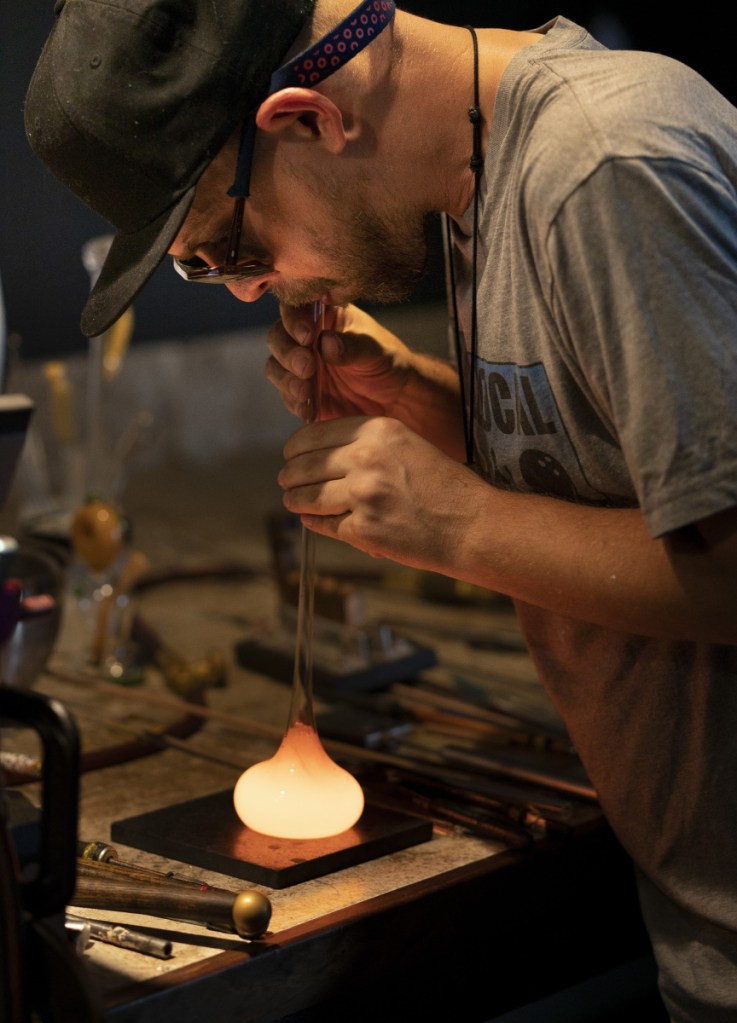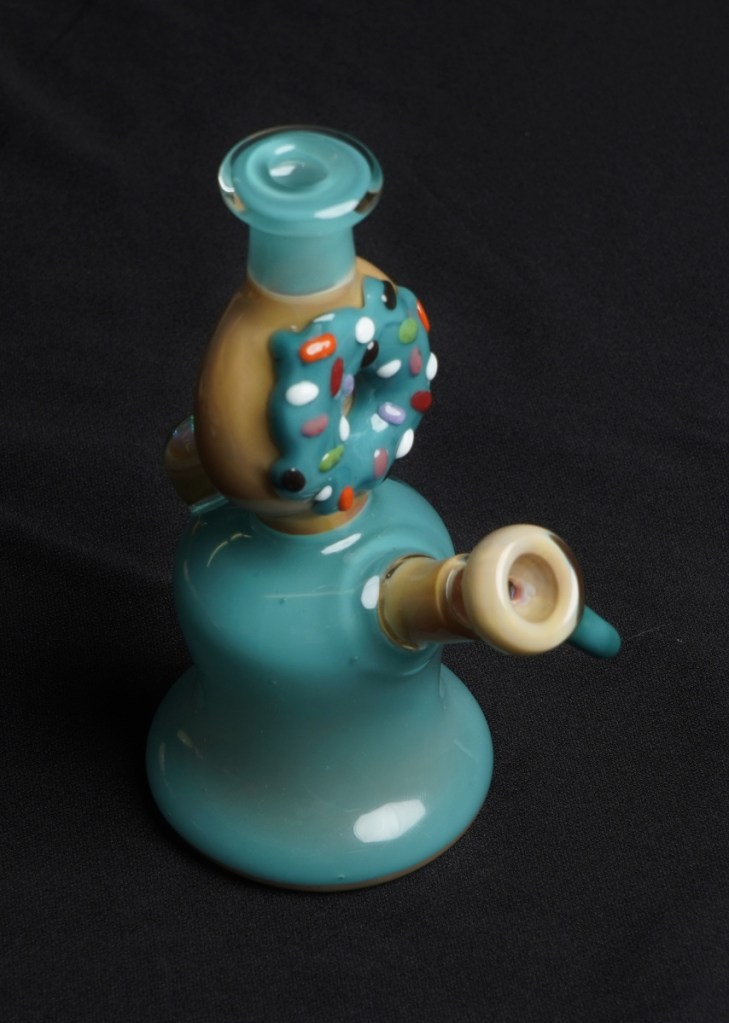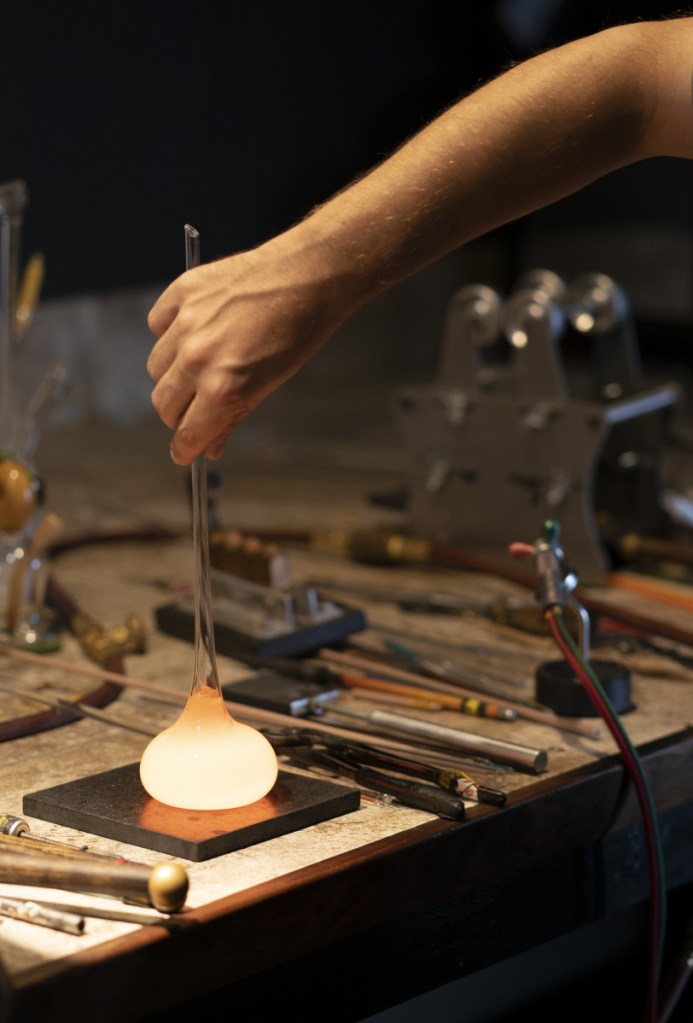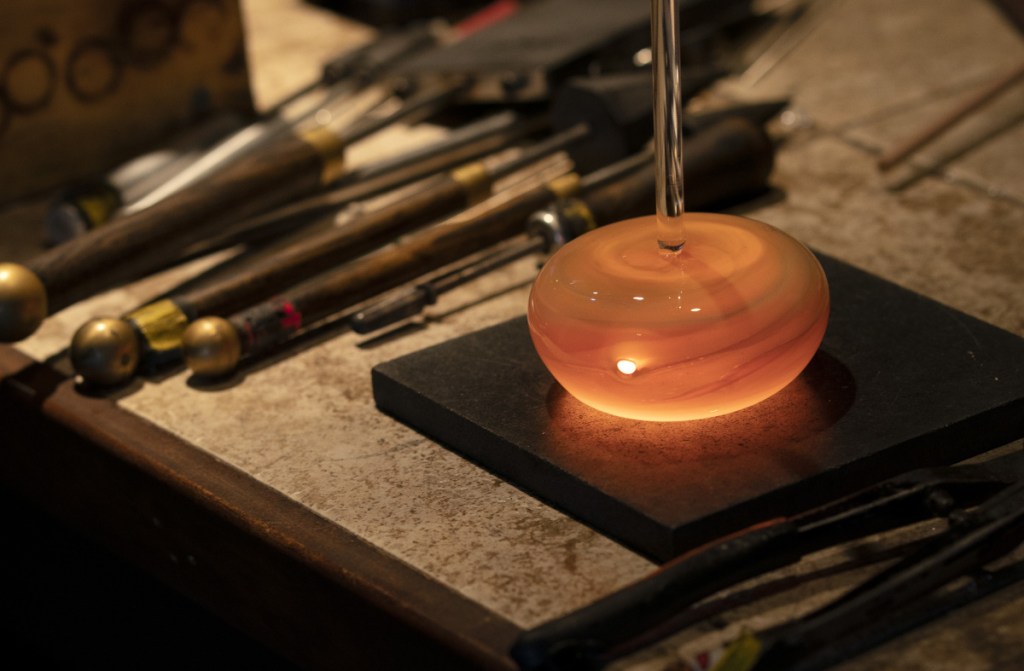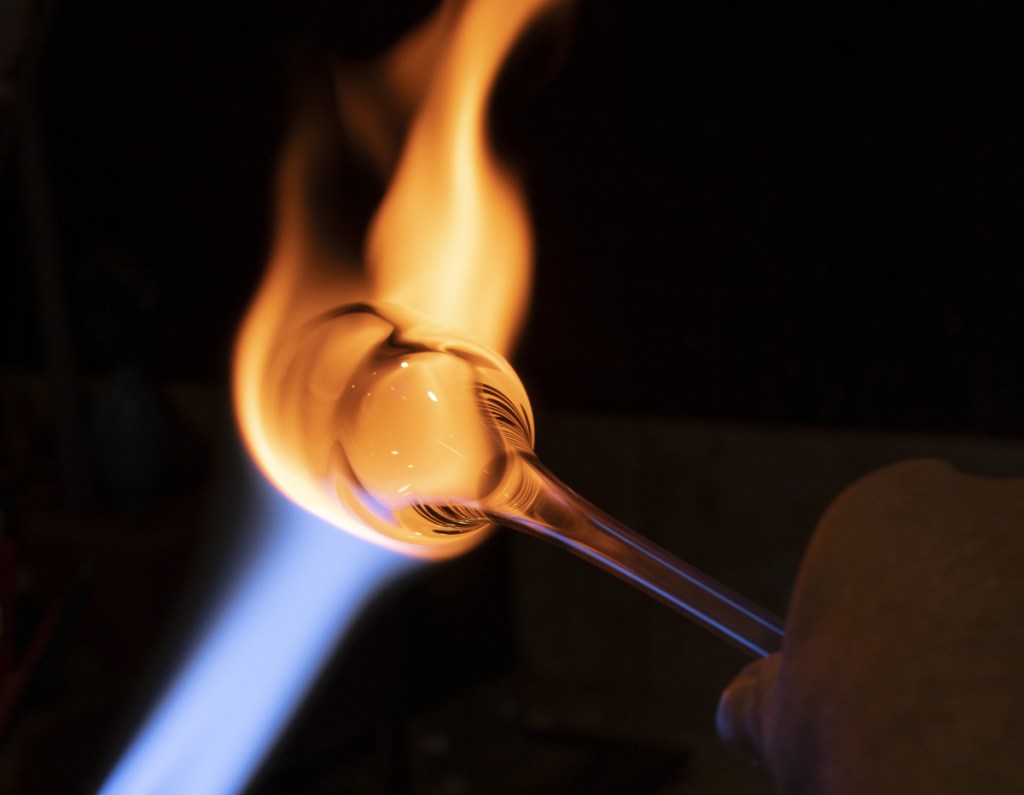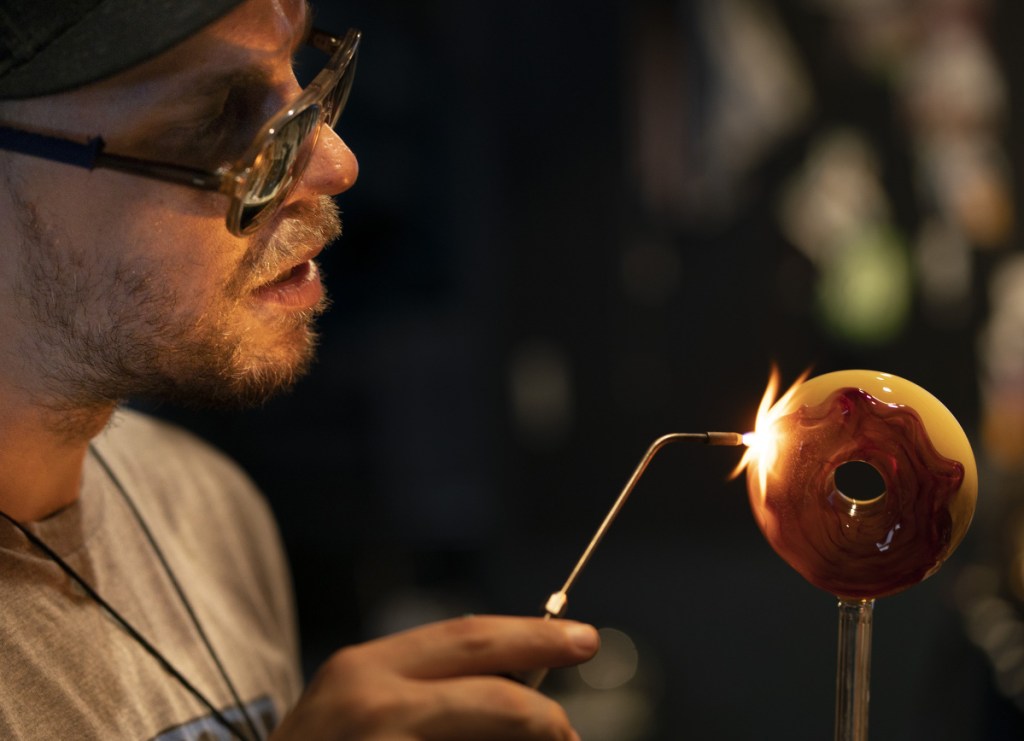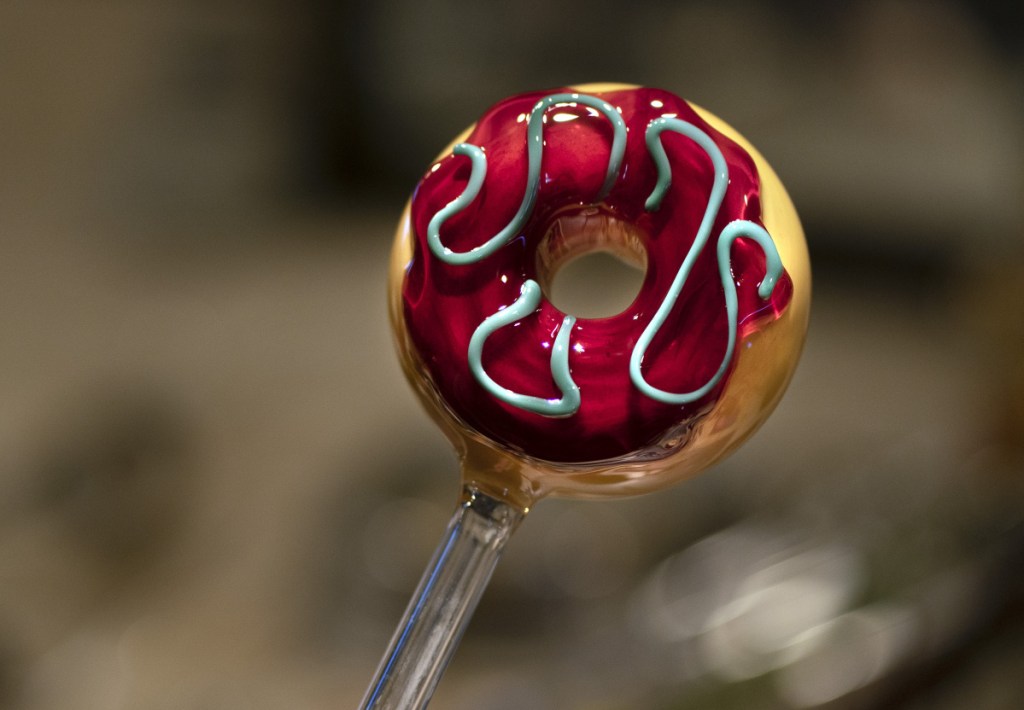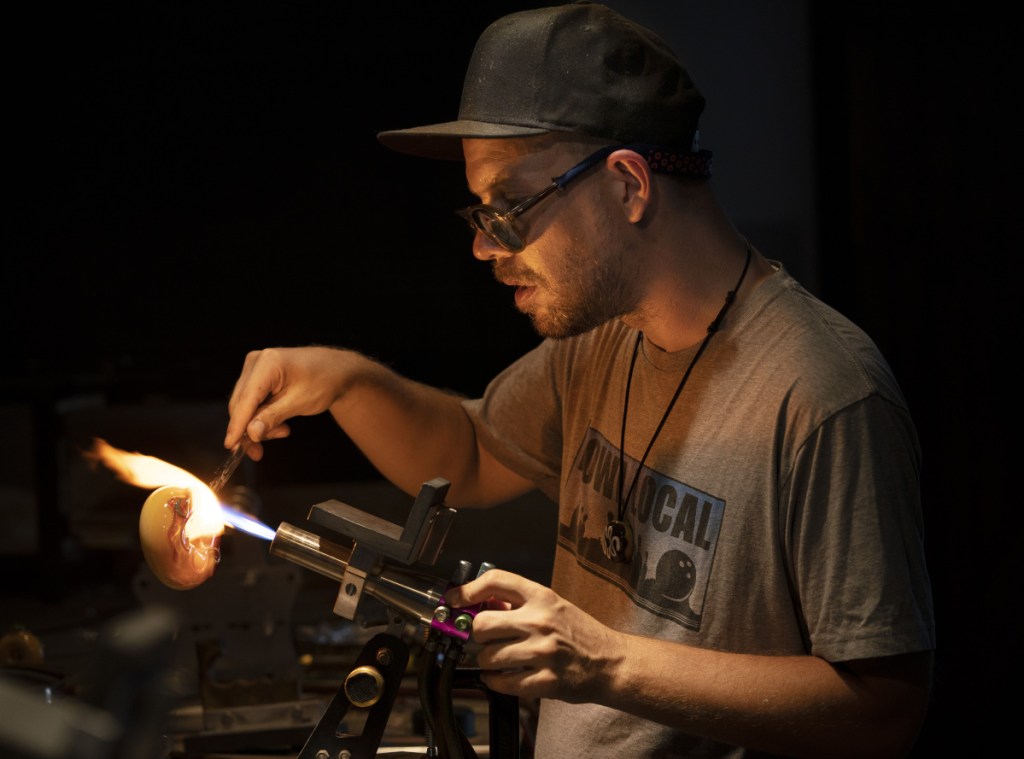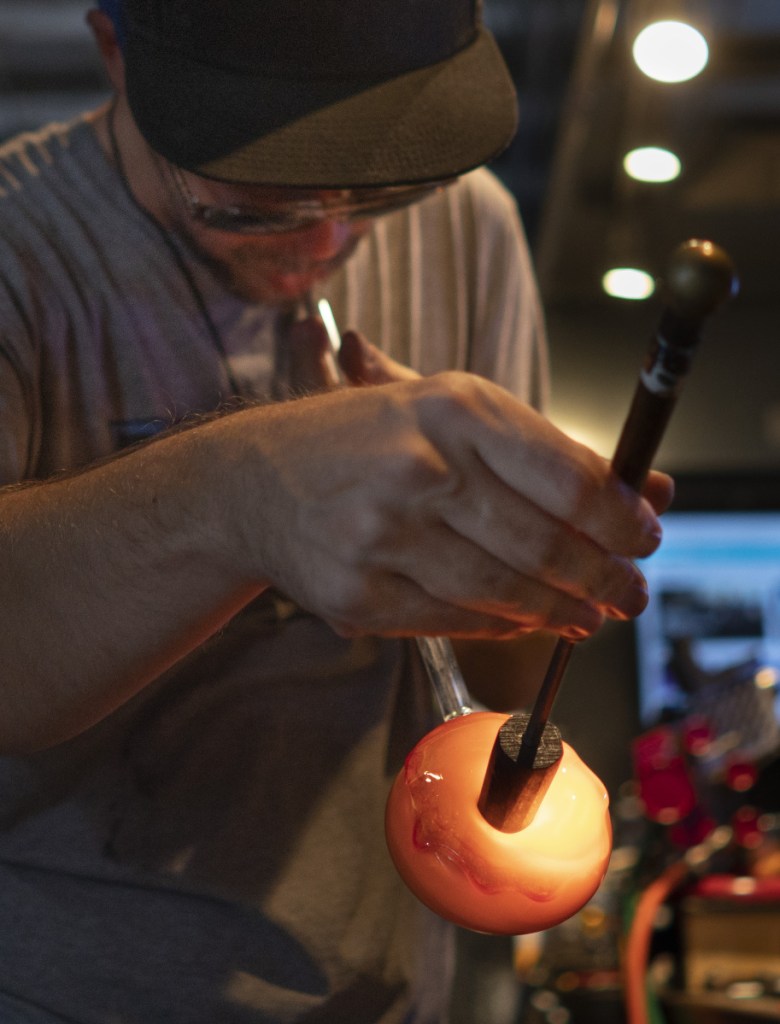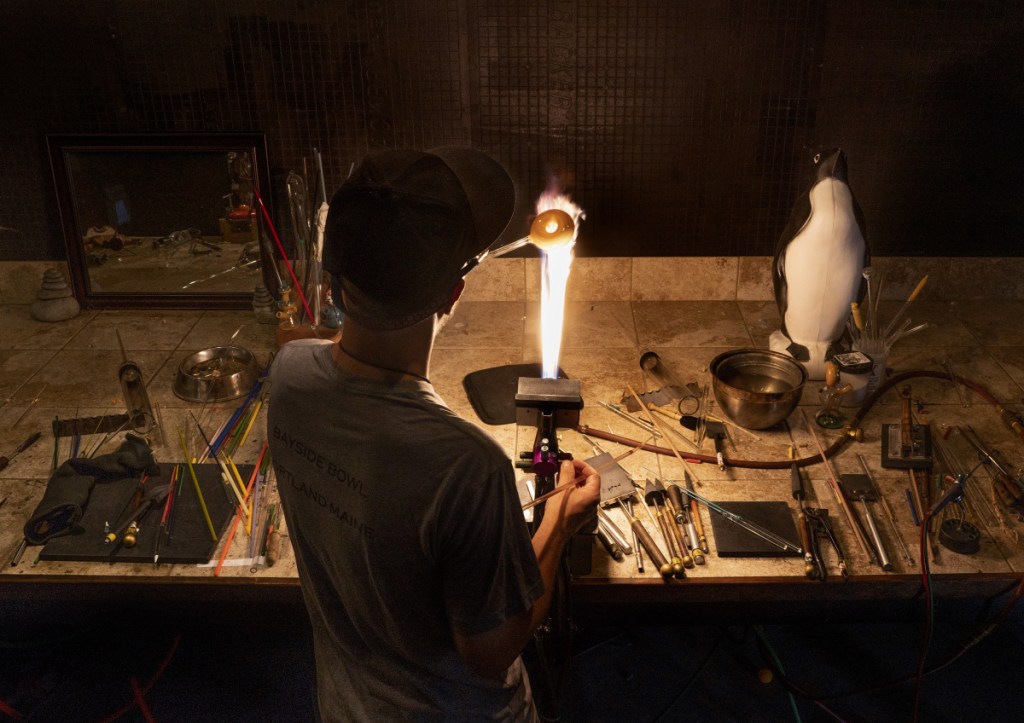Brian Owoc began his love affair with the torch when the itinerant baker met a group of glass artists at a 2000 Phish show.
Fascinated by the flame and the camaraderie, the Portland resident watched as they crafted glass rods into elaborate smoking pipes in a mind-bending range of sizes, colors and shapes. He soaked up as much as possible between shows and shifts at Dunkin’ Donuts. Two years later, he was trading glass-blowing lessons for space in his makeshift garage studio on Allen Avenue.
Five years later, after building up his skills, reputation and following, Owoc hit upon his artistic signature: the doughnut-shaped pipe.
“I was baking doughnuts all night and spending all day behind a torch,” Owoc recalled. “It’s only natural I’d eventually end up combining my passions, right? The first ones were pretty rough. I was living paycheck to paycheck, making just enough to cover rent, food and Phish tickets. But as I got better, and I learned how to glaze and frost them, things got crazy. By 2012, whoa.”
Now Owoc has a four-month waiting list for his doughnuts. One fan has collected more than 100 of them. A few have gotten tattoos of Owoc’s logo, KGB Glass. Even his smallest doughnut pipes and pendants cost more than $100, while some of the big elaborate pieces – like a doughnut-themed lava lamp pipe – sell for several thousand dollars each.
Owoc is one of the rock stars of Maine’s growing pipe-making community. No one knows how many people make pipes in Maine – after all, glass pipes are considered drug paraphernalia under a strict interpretation of federal law and even as recently as 15 years ago scores of U.S. pipemakers were arrested – but many in the industry put the number in the hundreds.
Although some will call it glass blowing, pipemakers are actually lamp working, using a torch, or flame, to manipulate the glass instead of a furnace, which is the primary heat source for traditional glass blowers. It is a practice that dates back to 14th-century Italy, when lamp workers would use oil lamps as their heat source. Now they use torches that burn propane, natural or butane gas.

Glass pipes incoporating doughnut designs created by Portland glass worker Brian Owoc. Owoc sells these pipes to collectors across the country, some of which fetch thousands of dollars.
The majority of them do what is called production work, making simple, utilitarian spoon-shaped pipes they can sell to glass shops for $30 to $40 a pop, said Brett Messer, who owns Exhale, a glass shop in Saco. Messer shows the work of 50 pipemakers in his shop, including 25 or so like Owoc, who have attained national fame and have graced the pages of High Times or Rolling Stone.
Since Maine legalized marijuana, Messer said many of these production artists can make enough pipes to make it a full-time job.
“Hundreds of Mainers are making a living from pipemaking,” said Kevin Conley, who works the counter at The Blazin’ Ace in Portland. “Used to be, pipemakers felt like they had to hide it, but with legalization, people are a lot more open about it, so the artists are able to come out into the open and teach new guys. The scene is really big, and it’s growing fast.”
A smaller but growing number of these pipemakers have evolved into functional glass artists, making more sophisticated and technical pieces that have more in common with a Chihuly sculpture than a Sherlock Holmes pipe. They may change color after being used, send the smoke flowing through a series of labyrinthine pipes, or take on the shape of a dragon, flower or doughnut.
“The big glass guys, they’re famous,” Conley said. “A lot of them I call my friends, but I kind of worship them, too. They’re geniuses.”
One of Owoc’s rabid fans is a young Portland glass collector known by the name of “Rigo” or his Instagram name “Lil_nugettt.” He will spend thousands on a new KGB glass piece, keeping all but one of them inside protective cases in his apartment until a special event, like his birthday. But he uses the doughnut-themed lava lamp pipe on an almost daily basis, he said.
“It’s just incredibly beautiful, so imaginative,” Rigo said. “It’s got a sense of humor about it, right? And it gives you a really good hit, too.”
The artists will collaborate with each other, blending styles and techniques to create some of the most expensive pieces on the market, and push each other to break the boundaries of what was believed possible at pipe-making competitions, like one held in September in Burlington, Vermont, called Pipe Classic. Many take on apprentices to help in the studio in exchange for lessons.

Glass worker Brian Owoc melts in “frosting” onto a doughnut pipe in his Portland studio on Monday, Aug. 13, 2018.
While there are pipemakers at work in studios, garages and renovated buses across the state, the high-end artists seem concentrated in Portland. Owoc can stand at his Kennebec Street studio and point to dozens of other pipemakers within a three-block radius, whose work can be found in high-end glass shops across the country.
Many have learned from pipemakers who have since left Maine for Washington, Oregon and California, places with big legal cannabis markets and collectors who can afford to buy their big-ticket pieces. Maine glass artists like Scott Rosinski and Steve Bates now live in California, producing work that sells for tens of thousands of dollars, but their protégés are still working in Maine.
Known in the glass world as “Mr. Gray,” a name he started using when he owned a head shop in downtown Gray, Rosinski got his first taste of glass at the Maine College of Art, where he enrolled in 1999 to learn how to make jewelry. At the time, MECA didn’t even have a glass program, but he got hooked on it when learning how to make jewelry beads.
“I went from beads to pipes pretty quick and I’ve been on a functional path ever since,” Rosinski said. “I still make jewelry, but some of the nicest glass being blown right now is on the pipe scene. Plenty of fine artists ostracized pipemaking, saying it’s not an art, but I say it serves a higher purpose because of the healing qualities of the plant. So it’s beautiful and sacred.”
Although it is growing in popularity, pipemaking is still considered the “red-headed stepchild of the glass world,” said Marty Kremer, a North Yarmouth glassblower who teaches MECA students at his home studio as part of the school’s continuing studies program. Pipemakers used to be the “bad kids,” but that image is fading slowly, he said.
“It’s a major part of American studio glass now,” Kremer said. “It’s not the mainstream, not yet, but it’s definitely the economic part. As studio art collectors are getting older, they are downsizing their collections of traditional glass. Schools are still churning out new glass workers, but the work is getting harder to sell. Apparently, selling these pipes, even the expensive ones, isn’t a problem.”
Kremer likened it to the booming market for glass sex toys.
“Some are really gorgeous pieces of art, but who wants to put that in a museum?” Kremer said. “It may be beautiful, but it is what it is.”
According to federal authorities, the pipe-making business is producing drug paraphernalia, or products primarily intended or designed for inhaling or consuming controlled substances. While Maine has legalized adult-use and medical cannabis, and would not consider it to be paraphernalia, federal law treats marijuana as a controlled substance and glass pipes as paraphernalia.
In 2003, the U.S. Department of Justice arrested 55 people for making marijuana pipes or bongs under the federal drug paraphernalia statute as part of a nationwide investigation called Operation Pipe Dream. The highest profile of the arrests – none of which took place in Maine – led to a nine-month federal prison sentence for actor Tommy Chong, owner of a pipe-making business.
That’s one of the reasons why some pipemakers, especially older ones who lived through Operation Pipe Dream, are reluctant to use their legal names when selling their work, going instead by online monikers. Pipemakers like Owoc are careful to call what they make “water pipes.” And some put “for tobacco use only” stickers on their work, although Owoc doesn’t do that.
As time passes, however, that memory fades, and public acceptance of marijuana is helping to land the best of this outsider art on the shelves of local galleries, on the pages of art auction catalogs and in glass museums. Even the Corning Museum of Glass in New York, opened by the same company that makes Pyrex bakeware, has recently opened its doors to glass pipes.
The Portland pipe-making scene is hot enough to lure some of Maine’s most successful pipemakers back home. Rosinski is buying a property in the Belgrade Lakes region of Maine to build a seasonal pipe-making retreat for collaborating and emerging functional glass artists, something he hopes will help the region make deepen its mark on the national industry.
Send questions/comments to the editors.




